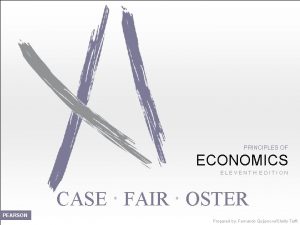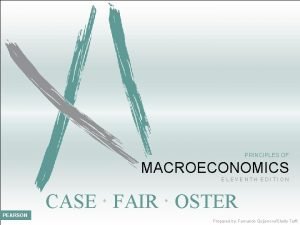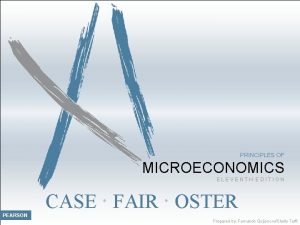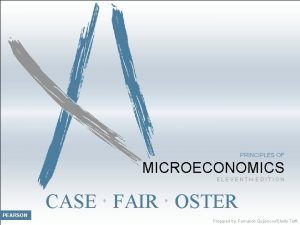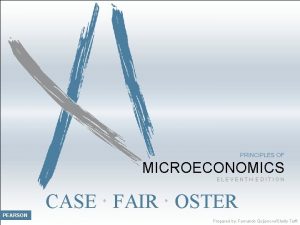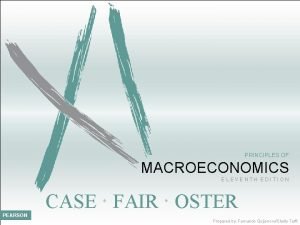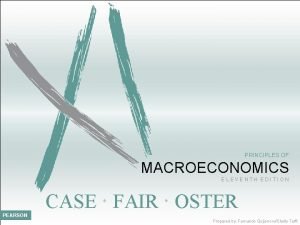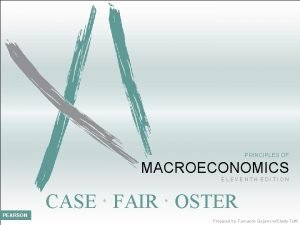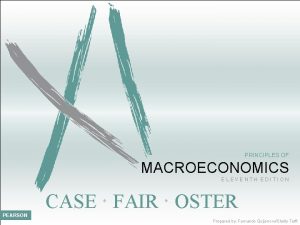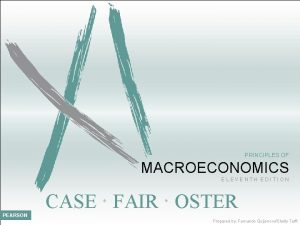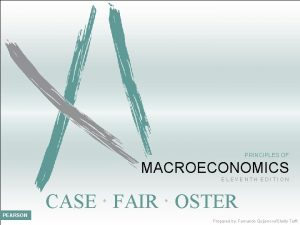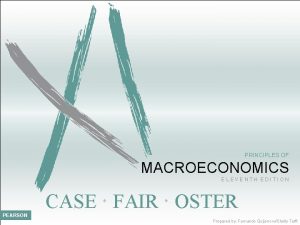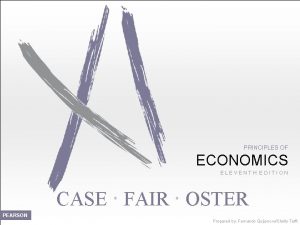PRINCIPLES OF MICROECONOMICS ELEVENTH EDITION CASE FAIR OSTER
















- Slides: 16

PRINCIPLES OF MICROECONOMICS ELEVENTH EDITION CASE FAIR OSTER PEARSON © 2014 Pearson Education, Inc. Prepared by: Fernando Quijano w/Shellyof. Tefft 16

© 2014 Pearson Education, Inc. 2 of 16

Monopolistic Competition 15 CHAPTER OUTLINE Industry Characteristics Product Differentiation and Advertising How Many Varieties? How Do Firms Differentiate Products? Advertising Price and Output Determination in Monopolistic Competition Product Differentiation and Demand Elasticity Price/Output Determination in the Short Run Price/Output Determination in the Long Run Economic Efficiency and Resource Allocation © 2014 Pearson Education, Inc. of 16

FIGURE 15. 1 Characteristics of Different Market Organizations © 2014 Pearson Education, Inc. 4 of 16

Industry Characteristics monopolistic competition A common form of industry (market) structure characterized by a large number of firms, no barriers to entry, and product differentiation. TABLE 15. 1 Percentage of Value of Shipments Accounted for by the Largest Firms in Selected Industries, 2002 Eight Twenty Largest Number of Four Largest Firms Industry Designation Travel trailers and campers 38 45 58 733 Games, toys 39 48 63 732 Wood office furniture 34 43 56 546 Book printing 33 54 68 560 Curtains and draperies 17 25 38 1, 778 Fresh or frozen seafood 14 24 48 529 Women’s dresses 18 23 48 528 Miscellaneous plastic 6 10 18 6, 775 products © 2014 Pearson Education, Inc. 5 of 16

Product Differentiation and Advertising product differentiation A strategy that firms use to achieve market power. Accomplished by producing goods that differ from others in the market. How Many Varieties? In well-working markets, the level of product variety reflects the underlying heterogeneity of consumers’ tastes in that market, the gains if any from coordination, and cost economies from standardization. In industries that are monopolistically competitive, differences in consumer tastes, lack of need for coordination, and modest or no scale economies from standardization give rise to a large number of firms, each of which has a different product. Even within this industry structure, however, these same forces play a role in driving levels of variety. © 2014 Pearson Education, Inc. 6 of 16

How Do Firms Differentiate Products? horizontal differentiation Products differ in ways that make them better for some people and worse for others. vertical differentiation A product difference that, from everyone’s perspective, makes a product better than rival products. behavioral economics A branch of economics that uses the insights of psychology and economics to investigate decision making. commitment device Actions that individuals take in one period to try to control their behavior in a future period. © 2014 Pearson Education, Inc. 7 of 16

ECONOMICS IN PRACTICE An Economist Makes Tea Despite the higher price of Honest Tea, some consumers choose it over the alternatives. Economist Barry Nalebuff used economic theory to differentiate his tea from others in the industry. The graph shows how taste varies with sugar for potential customers. Notice the placement of the popular flavor, Green Dragon, to the left of the taste peak. Nalebuff discovered that sugar beyond some point adds little taste, yet comes at a health cost—more calories. Given consumers’ new awareness of healthy and natural foods, Honest Tea became an overnight success. THINKING PRACTICALLY 1. What would you expect to see happen to the placement of Green Dragon Tea if we discovered sugar was good for us? © 2014 Pearson Education, Inc. 8 of 16

Advertising One role advertising plays is to inform people about the real differences that exist among products. Advertising can also create or contribute to product differentiation, creating a brand image for a product that has little to do with its physical characteristics. The Case for Advertising Differentiated products and advertising give the market system its vitality and are the basis of its power. Product differentiation helps to ensure high quality and variety, and advertising provides consumers with valuable information on product availability, quality, and price that they need to make efficient choices in the marketplace. © 2014 Pearson Education, Inc. 9 of 16

The Case Against Product Differentiation and Advertising The bottom line, critics of product differentiation and advertising argue, is waste and inefficiency. Enormous sums are spent to create minute, meaningless, and possibly nonexistent differences among products. Advertising raises the cost of products and frequently contains very little information. Often, it is merely an annoyance. Advertising can lead to unproductive warfare and may serve as a barrier to entry, thus reducing real competition. Open Questions There are strong arguments on both sides of the advertising debate, and even the empirical evidence yields conflicting conclusions. Some studies show that advertising leads to concentration and positive profits; others, that advertising improves the functioning of the market. © 2014 Pearson Education, Inc. 10 of 16

ECONOMICS IN PRACTICE Can Information Reduce Obesity? Policy makers have been working to increase the level of information that consumers have about products. In the early 1990 s, the Food and Drug Administration passed rules requiring most processed foods sold in grocery stores to carry nutrition labels. The current hot topic in the labeling area involves restaurant meals. With obesity growing in the United States, many policy makers think that one way to fight the problem is to require calorie and fat labeling in restaurants. In Europe, which is facing its own obesity issues, there have been calls to regulate how certain foods are marketed, especially to children. THINKING PRACTICALLY 1. Using supply and demand curves, contrast taxes on sugar with advertising limits on sugar-laden goods as ways to reduce the consumption of these goods. © 2014 Pearson Education, Inc. 11 of 16

Price and Output Determination in Monopolistic Competition Product Differentiation and Demand Elasticity FIGURE 15. 2 Product Differentiation Reduces the Elasticity of Demand Facing a Firm The demand curve that a monopolistic competitor faces is likely to be less elastic than the demand curve that a perfectly competitive firm faces. Demand is more elastic than the demand curve that a monopolist faces because close substitutes for the products of a monopolistic competitor are available. © 2014 Pearson Education, Inc. 12 of 16

Price/Output Determination in the Short Run FIGURE 15. 3 Monopolistic Competition in the Short Run In the short run, a monopolistically competitive firm will produce up to the point MR = MC. At q 0 = 2, 000 in panel a, the firm is earning short-run profits equal to P 0 ABC = $2, 000. In panel b, another monopolistically competitive firm with a similar cost structure is shown facing a weaker demand suffering short-run losses at q 1 = 1, 000, equal to CABP 1 = $1, 000. © 2014 Pearson Education, Inc. 13 of 16

Price/Output Determination in the Long Run FIGURE 15. 4 Monopolistically Competitive Firm at Long-Run Equilibrium As new firms enter a monopolistically competitive industry in search of profits, the demand curves of existing profit-making firms begin to shift to the left, pushing marginal revenue with them as consumers switch to the new close substitutes. This process continues until profits are eliminated, which occurs for a firm when its demand curve is just tangent to its average total cost curve. © 2014 Pearson Education, Inc. 14 of 16

Economic Efficiency and Resource Allocation Because entry is easy and economic profits are eliminated in the long run, we might conclude that the result of monopolistic competition is efficient. There are two problems, however. First, once a firm achieves any degree of market power by differentiating its product (as is the case in monopolistic competition), its profit-maximizing strategy is to hold down production and charge a price above marginal cost. Second, the final equilibrium in a monopolistically competitive firm is necessarily to the left of the low point on its average total cost curve, which means a typical firm in this industry will not realize all the economies of scale available. Nonetheless, if product differentiation leads to the introduction of new products, improvements in old products, and greater variety, an important gain in economic welfare may counteract (and perhaps outweigh) the loss of efficiency from pricing above marginal cost or not fully realizing all economies of scale. © 2014 Pearson Education, Inc. 15 of 16

REVIEW TERMS AND CONCEPTS behavioral economics commitment device horizontal differentiation monopolistic competition product differentiation vertical differentiation © 2014 Pearson Education, Inc. of 16
 Principles of economics case fair oster
Principles of economics case fair oster Principles of macroeconomics case fair oster
Principles of macroeconomics case fair oster Management eleventh edition
Management eleventh edition Management 11th edition by stephen p robbins
Management 11th edition by stephen p robbins Management eleventh edition
Management eleventh edition Management eleventh edition stephen p robbins
Management eleventh edition stephen p robbins Macroeconomics michael parkin 13th edition
Macroeconomics michael parkin 13th edition Vicky thorland-oster
Vicky thorland-oster Oster 3000
Oster 3000 Sarah jacobson williams
Sarah jacobson williams 22 rents
22 rents Chadha committee
Chadha committee Eleventh 5 year plan
Eleventh 5 year plan Thfive
Thfive For his eleventh birthday elvis presley
For his eleventh birthday elvis presley Shakespearean sonnet
Shakespearean sonnet Foul is fair and fair is foul literary device
Foul is fair and fair is foul literary device
